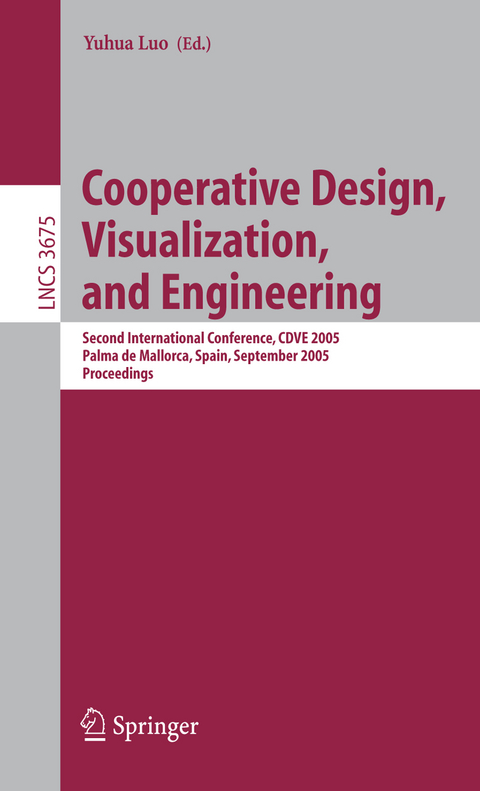
Cooperative Design, Visualization, and Engineering
Springer Berlin (Verlag)
978-3-540-28948-7 (ISBN)
Building a CSCW Infrastructure Utilizing an M&S Architecture and XML.- Modelization of a Communication Protocol for CSCW Systems Using Coloured Petri Nets.- The Design of a Workflow-Centric, Context-Aware Framework to Support Heterogeneous Computing Environments in Collaboration.- Do Tangible User Interfaces Impact Spatial Cognition in Collaborative Design?.- Cooperation in Highly Distributed Design Processes: Observation of Design Sessions Dynamics.- Designing Display-Rich Environments for Collaborative Scientific Visualization.- Visualization of Interactions Within a Project: The IVF Framework.- An Interaction Interface for Multiple Agents on Shared 3D Display.- Concurrency Control and Locking in Knowledge Base for Rapid Product Development.- Collaborative Solution for Cooperation, Coordination and Knowledge Management in the Ceramic Tile Design Chain.- GCE: Knowledge Management Applied in a Design Reengineering Process.- A Constraint Maintenance Strategy and Applications in Real-Time Collaborative Environments.- Design of a Cooperative Working Environment for Mobile Devices.- Mobility in Environmental Planning: An Integrated Multi-agent Approach.- Research on Mobile Agent Based Information Content-Sharing in Peer to Peer System.- Environmentally-Aware Security Enforcement (EASE) for Cooperative Design and Engineering.- Grid Workflow Scheduling Based on Task and Data Locations.- The Construction Management Cooperated with Clients Using a Parametric Information Design Method.- Theoretical Foundations for Knowledge-Based Conceptual Design of Complex Systems.- Public Digital Collaboration in Planning.- Designing Virtual Reality Reconstruction of the Koguryo Mural.- A Cooperative System Environment for Design, Construction and Maintenance of Bridges.- A Concurrent Approach to Design of Reconfigurable Machine Tools to Process Bamboo.- Model for an Integrated Analysis of a Building's Life Cycle.- Cooperative Shared Learning Objects in an Intelligent Web-Based Tutoring System Environment.- Cooperative Integrated Web-Based Negotiation and Decision Support System for Real Estate.- A Directed Evolution Modularity Framework for Design of Reconfigurable Machine Tools.- Study of the Intelligent Turning Machining Method Based on Geometrical Feature Recognition.
| Erscheint lt. Verlag | 6.9.2005 |
|---|---|
| Reihe/Serie | Information Systems and Applications, incl. Internet/Web, and HCI | Lecture Notes in Computer Science |
| Zusatzinfo | XI, 264 p. |
| Verlagsort | Berlin |
| Sprache | englisch |
| Maße | 155 x 235 mm |
| Gewicht | 427 g |
| Themenwelt | Mathematik / Informatik ► Informatik ► Betriebssysteme / Server |
| Informatik ► Software Entwicklung ► User Interfaces (HCI) | |
| Schlagworte | CAD • collaborative desogn environments • Computer Aided Design • Computer supported cooperative work • concurrency control • constraint maintenance • cooperative business management • cooperative engineering • cooperative systems design • cooperative visualizatio • cooperative visualization • Cooperative Work • decision support • HCI • Interface Agents • knowledge management • Management • multimodal interaction • security • security enforcement • Virtual Reality • Visualization • Web-Based Cooperation |
| ISBN-10 | 3-540-28948-8 / 3540289488 |
| ISBN-13 | 978-3-540-28948-7 / 9783540289487 |
| Zustand | Neuware |
| Haben Sie eine Frage zum Produkt? |
aus dem Bereich


